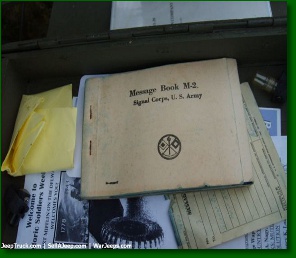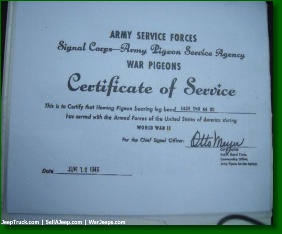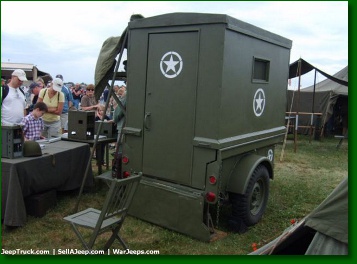

















|
|
|
|
Tell
your friends about this Article with your social network or email
Share
We first met Andrew Sinkleris, "Andy" at the Reading
Airshow - World War II Weekend in Reading, Pennsylvania
The World War II Weekend in Reading, PA is one of the finest displays of World War II military vehicles and war birds that we have ever seen. This is no static display, as you walk around the show military jeeps and vehicles zip around as war birds buzz overhead. Reenactors help to complete the picture as you are transported back in time.
The World War II Weekend in Reading, PA is one of the finest displays of World War II military vehicles and war birds that we have ever seen. This is no static display, as you walk around the show military jeeps and vehicles zip around as war birds buzz overhead. Reenactors help to complete the picture as you are transported back in time.
As we rounded the corner among these many Word War II era vehicles and planes we spotted
Andy’s unique Bantam Jeep trailer. Andy’s Bantam Jeep trailer wasn’t like any we had ever seen
before. The Bantam Jeep trailer had been converted into a military mobile homing pigeon loft. These
mobile lofts were designed to house and transport homing pigeons which carry messages across
enemy lines. The homing pigeons would be carried into battle in special crates and would be used
when there was no other means of getting word back when help was desperately needed. Each box
or crate would carry two pigeons with message capsules which would be fastened to the pigeon’s leg.
Andy claims that radios back in the day only had 86% reliability so pigeons were a good alternative.
In fact homing pigeons have been used throughout
military history as far back as the Roman Legions.
The Romans utilized the pigeons to carry messages
with news from the front back to Rome. In this
same capacity homing pigeons were used to rescue
soldiers along the front lines during World War I,
World War II and the Korean War. Andy states
1918 was the year the U.S. started the Signal
Pigeon Corps. Although the Italian’s and English all
had pigeon corps before the United States. In the
end the Pigeon Corps. was taken out of service in
1957 with Switzerland being the last country to
give it up.
Andy known as “Pigeon Andy” by his fellow reenactors is a member of the U.S. Army Signal Corps,
280th Signal Pigeon Company, 1st Infantry Division Reenacted. Andy hails from Riverside, NJ and is a
wealth of knowledge regarding, military mobile lofts, homing pigeons and pigeoneers. Pigeoneers were
the enlisted men who trained and cared for the military’s homing pigeons, mobile lofts and the
lifesaving messages they carried. These mobile lofts were typically moved 25 miles at a time to their
new locations. It took seven to eight days to get setup and let the pigeons adapt to their new location.
Andy said the military even experimented with night flyers for a time, these were pigeons that would
fly through the night.
In fact Andy’s fascination with pigeons
can be attributed to his Uncle Frank
Sinkleris who served our country as a
member of the 828th Signal Pigeon
Replacement Company based in Camp
Edison, Fort Monmouth, NJ. Andy
reports that during World War II
30,000 pigeons were deployed, 65,000
pigeons were trained, 3,000 troops
were trained in the care and handling
of the pigeons, 250 were officers and
there were 14 Signal Pigeon Company’s.
He also states that 3,000 pigeons also
participated in the invasion of
Normandy.
In order to recreate the mobile loft
Andy’s Bantam trailer was converted
in much the same way mobile lofts
were constructed during World War II.
Plywood was used to construct the loft
that sits atop the Bantam trailer with
other lumber and screening used to
construct the attached fly pen for the
pigeons. Like Andy’s each loft also
contained a medical kit used to patch
up any pigeons that came back
wounded. Andy then topped of his
Bantam trailer conversion with Olive
drab paint from Army Jeep Parts in
Levittown, PA. The Bantam T3 trailers
were manufactured by the American
Bantam Car Company out of Butler PA
for use during World War II as a
companion to the Bantam Jeep. In fact
the Bantam Jeep can be credited as
the first Jeep ever manufactured
based on a design by Karl Probst. The
US Army needed a four wheel drive
reconnaissance car to meet it’s needs
during World War II and the American
Bantam Car Company delivered the
prototype in just 49 days.
In conclusion, the homing pigeons used during the war were bred for stamina, speed and homing
ability. In fact Andy’s pigeons were from a strain bred in Belgium. Some of these war time pigeons
became decorated heroes, one such pigeon was Cher Ami (Dear friend). During World War I five
hundred soldiers were trapped behind enemy lines without food or ammunition. Surrounded by
Germans, and suffering many casualties only 200 soldiers had survived into the second day. Then
against all odds and being shot at by Germans Cher Ami was able to make it back wounded to HQ
with the message that saved the remaining 200 soldiers. Another famous pigeon G.I. Joe was
awarded for his service in the United States Army Signal Pigeon Corps. G.I. Joe saved the lives of
over a thousand people during World War II . The town of Calvi Vecchia, Italy was scheduled to be
bombarded on October of 1943 by allied forces. The British had just regained control of the town in
advance of the bombing raid and G.I. Joe delivered the message just in time to stop the raid.
To read more about the Signal Pigeon Corps including pictures you can visit the interesting links below
for more information.
Link to the 828th history.
http://cecomhistorian.armylive.dodlive.mil/2011/10/11/pigeons-as-pure-gi-soldiers/
Frank Hauck of Signal Pigeon Company, WWII
http://www.frankhauck.blogspot.com/
This article is dedicated to Andy’s Uncle Frank Sinkleris who served our country as a member of the 828th Signal Pigeon Replacement Company based in Camp Edison, Fort Monmouth, NJ
It is also dedicated to a dear friend of mine Danny Quill a World War II veteran and avid pigeon racer and fancier. Danny served with the 91st Division as a member of the 362nd Infantry Unit. Andy’s pictures and story brought much joy to Danny in his final days at the age of 96. It invoked memories of his meetings with pigeoneers both during and after World War II.
For more information on the World War II Weekend in Reading, Pennsylvania click on the link below
http://maam.org/maamwwii.html
Mark Smith – Editor/Publisher WarJeeps.com
Link to the 828th history.
http://cecomhistorian.armylive.dodlive.mil/2011/10/11/pigeons-as-pure-gi-soldiers/
Frank Hauck of Signal Pigeon Company, WWII
http://www.frankhauck.blogspot.com/
This article is dedicated to Andy’s Uncle Frank Sinkleris who served our country as a member of the 828th Signal Pigeon Replacement Company based in Camp Edison, Fort Monmouth, NJ
It is also dedicated to a dear friend of mine Danny Quill a World War II veteran and avid pigeon racer and fancier. Danny served with the 91st Division as a member of the 362nd Infantry Unit. Andy’s pictures and story brought much joy to Danny in his final days at the age of 96. It invoked memories of his meetings with pigeoneers both during and after World War II.
For more information on the World War II Weekend in Reading, Pennsylvania click on the link below
http://maam.org/maamwwii.html
Mark Smith – Editor/Publisher WarJeeps.com
by Mark Smith